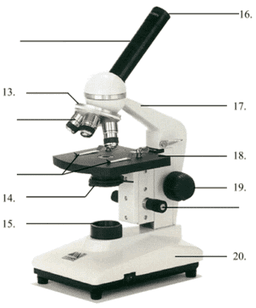
2.1 Cell Discovery and Theory Quiz
Quiz by Maya Serhan
Feel free to use or edit a copy
includes Teacher and Student dashboards
Measure skillsfrom any curriculum
Measure skills
from any curriculum
Tag the questions with any skills you have. Your dashboard will track each student's mastery of each skill.
With a free account, teachers can
- edit the questions
- save a copy for later
- start a class game
- automatically assign follow-up activities based on students’ scores
- assign as homework
- share a link with colleagues
- print as a bubble sheet
11 questions
Show answers
- Q11. When looking at a specimen on your slide, you should always start with thehigh objective lensmedium objective lenslow objective lensblank objective lens60s
- Q22. You can find total magnification by which of the following methods?adding the eyepiece and the objective lensmultiplying the eyepiece and the objective lensadding the eyepiece and all of the objective lensesmultiplying the eyepiece and all of the objective lenses60s
- Q33. Find total magnification for: Eyepiece = 10X Objective lens = 40X20X400X50X40X60s
- Q44. What is number 15?light sourcecoarse adjustment knobbasefine adjustment knob60s
- Q55. What is number 19?fine adjustment knoblight sourcecoarse adjustment knobdiaphragm60s
- Q66. What is the function of stage clips?To adjust the focusTo move the objectivesTo keep the slide secureTo look through60s
- Q77. Which of the below is NOT a principle of the cell theory?All living cells are composed of single cellsCells arise from previously existing cellsCells pass on copies of their genetic material to daughter cellsCells are the basic unit of structure and organization of all living organisms60s
- Q88. Which of the below is used to see an image on a compound microscope?lightheatcolorelectrons60s
- Q99. Which type of microscope would you use to view details of a living small water flea in pond water?Scanning tunneling electron microscopeTransmission electron microscopeScanning electron microscopeLight microscope60s
- Q1010. What is the maximum magnification of a light microscope?10,000X1000X500,000X40X60s
- Q1111. The image is showing a very small deep sea creature. What type of microscope would have been used to create the image?light microscopetransmission electron microscopescanning electron microscope60s